Many people are curious about how a pulse can reveal issues within the body.
I remember watching a short video about a Traditional Chinese Medicine (TCM) class in university, where the teacher was demonstrating “pulse diagnosis” and asked if anyone wanted to try. The teacher was an expert, and usually, one would have to wait in line to consult him.
As a result, many students raised their hands, and the teacher began to take pulses. When he placed his hand on a young girl’s pulse, he asked if her menstrual cycle had started, leaving the student astonished. She wondered how he could tell, and the teacher replied that if she listened carefully in class, she would gradually understand.
There are many such examples; for instance, pregnancy can also be detected through pulse diagnosis, which demonstrates the incredible treasures left by our ancestors that we need to inherit and promote.

Many patients who come to my clinic also find pulse diagnosis fascinating and often ask what the pulse of a nodule feels like. Different constitutions exhibit different pulse patterns under various conditions.
Yesterday, a 36-year-old female patient with breast nodules sought TCM treatment. Her pulse was tight and wiry, with stagnation in the left guan position. Many people may wonder about their own pulse patterns, so let’s explore this together.
Everyone has heard of the four diagnostic methods: “observation, listening, inquiry, and palpation.” The “palpation” refers to feeling the patient’s pulse to assess the pulse pattern, which is a crucial step in face-to-face diagnosis.
The pulse pattern is a very important basis for diagnosis in TCM. Based on long-term accumulation, pulse patterns are classified into twenty-eight types, such as floating pulse (fu mai), sinking pulse (chen mai), slow pulse (chi mai), rapid pulse (shuo mai), thin pulse (xi mai), surging pulse (hong mai), wiry pulse (xian mai), slippery pulse (hua mai), rough pulse (se mai), empty pulse (xu mai), and full pulse (shi mai), among others. Each pulse pattern corresponds to various diseases, which helps in diagnosing illnesses.
This may be a bit difficult for non-medical students, but it does not hinder our understanding of the profoundness of TCM. Let’s learn together.
In ancient pulse diagnosis, there were three parts and nine conditions, as well as the cun-kou (寸口) method. Nowadays, pulse diagnosis generally uses the cun-kou method, which refers to the radial artery pulse.
First, let’s look at a normal pulse: it is generally neither floating nor sinking, neither large nor small, neither strong nor weak, neither fast nor slow, but rather even and gentle, with a regular rhythm, also known as a ping mai (平脉) or huan mai (缓脉). A normal pulse beats four to five times per breath (one inhalation and one exhalation), equivalent to 72-80 beats per minute, with consistent rhythm and strength.
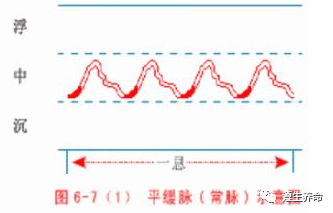
How do we take a pulse?
First, it is essential to know the pulse-taking locations and what the left and right hands represent in terms of organs (“cun, guan, chi” -寸关尺).
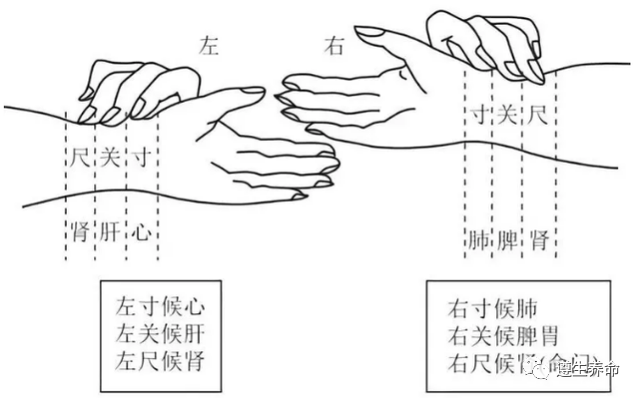
Second, pulse-taking involves tactile sensations, which include six types of feelings: pulse position (floating, middle, sinking), pulse strength (force), pulse body (length, thickness), rate, rhythm, and hardness (softness or hardness of the pulse body).
Third, the mnemonic for pulse diagnosis:
The method of pulse-taking has true transmission; the twenty-eight pulses are not ordinary. Floating, sinking, slow, and rapid are the four fundamental pulses, each requiring careful study. For floating pulses, five types must be clearly examined (ru, ge, hong, wei, san); for sinking pulses, four types must be understood (fu, xi, lao, ruo); and within floating and sinking, four types must be identified (xu, shi, kou, chang).
So how do we specifically identify pulse patterns?
Step one: distinguish between floating and sinking pulses. By probing from shallow to deep, we can determine whether the disease is superficial or internal.
1. Lift: First, gently touch the surface to check for a floating pulse.
2. Seek: If no floating pulse is found, apply more pressure to feel various pulse patterns.
3. Press: Then apply a third level of pressure to check for a sinking pulse.
Next, let’s look at what different pulses indicate in terms of diseases.
(1) Floating pulse:
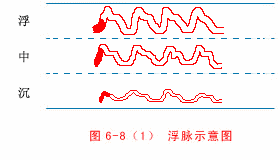
【Body Image Song】 Floating on the skin, like wood floating on water; it is abundant when lifted, but insufficient when pressed.
【Main Disease Song】 Floating pulse is yang, indicating a disease on the surface. A floating pulse at the cun position indicates a cold; a floating pulse at the left guan indicates wind in the middle jiao; a floating pulse at the right guan indicates wind-phlegm in the diaphragm; a pulse at the chi position indicates wind in the lower jiao, with difficulty in urination and constipation.
(2) Sinking pulse:
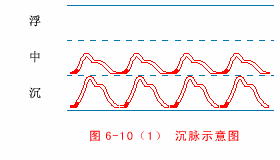
【Body Image Song】 Sinking pulse travels through the muscles and bones, like a stone sinking in water; it is abundant when pressed, but insufficient when lifted.
【Main Disease Song】 Sinking pulse is yin, indicating an internal disease. A sinking pulse at the cun position indicates shortness of breath and chest pain; it may also indicate phlegm or water and blood issues. A sinking pulse at the guan position indicates internal cold, leading to pain and knots; it may also indicate fullness and discomfort, with acid reflux and muscle tension. A sinking pulse at the chi position indicates back pain and also relates to dampness and itching.
(3) Slow pulse:
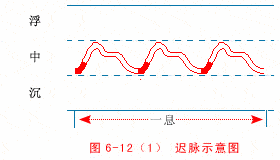
【Body Image Song】 Slow pulse belongs to yin, indicating insufficiency; it is slow and takes three beats per breath.
【Main Disease Song】 Slow pulse indicates organ issues, primarily due to cold. A slow pulse at the cun position indicates heart pain and stagnation; a slow pulse at the guan position indicates internal cold and muscle spasms; a slow pulse at the chi position indicates fire deficiency, leading to incontinence and potential pain in the waist and legs.
(4) Rapid pulse:

【Body Image Song】 Rapid pulse belongs to yang, indicating excess; it beats six times per breath, with rapid fluctuations.
【Main Disease Song】 Rapid pulse indicates issues with the fu organs, primarily due to heat. A rapid pulse at the cun position indicates wheezing and cough, with mouth sores; a rapid pulse at the guan position indicates stomach heat and upward attacking evil fire; a rapid pulse at the chi position indicates relative fire, leading to incontinence and dampness.
(5) Slippery pulse:

【Body Image Song】 Slippery pulse flows smoothly, like beads rolling; it signifies the essence of dew.
【Main Disease Song】 Slippery pulse is yang, often indicating phlegm and fluids. A slippery pulse at the cun position indicates cough; fullness in the chest and nausea; a slippery pulse at the guan position indicates stomach heat, obstructed qi, and food injury; a slippery pulse at the chi position indicates issues with dampness, possibly leading to dysentery, blood in urine, or menstrual issues in women.
(6) Rough pulse:

【Body Image Song】 Rough pulse is stagnant, like a knife scraping bamboo; it is slow, thin, and short, with three signs of fear.
【Main Disease Song】 Rough pulse indicates blood deficiency and also signifies damage to essence. A rough pulse at the cun position indicates heart pain, possibly leading to palpitations; a rough pulse at the guan position indicates yin deficiency, leading to internal heat; a rough pulse at the right guan indicates spleen deficiency and bloating. A rough pulse at the chi position indicates incontinence and blood issues; during pregnancy, it may indicate fetal issues or blood loss.
(7) Empty pulse:

【Body Image Song】 Empty pulse is soft and weak; it is almost imperceptible when pressed.
【Main Disease Song】 Empty pulse indicates blood deficiency and also signifies heat injury. A left cun pulse indicates heart deficiency, leading to anxiety; a right cun pulse indicates lung deficiency, leading to spontaneous sweating. A left guan pulse indicates liver injury, leading to insufficient nourishment of tendons; a right guan pulse indicates spleen cold, leading to poor digestion. A left chi pulse indicates water deficiency, leading to weakness in the waist and knees; a right chi pulse indicates fire deficiency, leading to cold symptoms.
(8) Full pulse:

【Body Image Song】 Full pulse is strong, long, and firm; it responds vigorously to pressure, consistent across all three conditions.
【Main Disease Song】 Full pulse indicates blood excess and heat stagnation. A full pulse at the left cun indicates heart strain, with a strong tongue and surging qi; a full pulse at the right cun indicates lung disease, with nausea and throat pain. A full pulse at the left guan indicates liver fire pain; a full pulse at the right guan indicates fullness and pain. A full pulse at the left chi indicates constipation and abdominal pain; a full pulse at the right chi indicates excessive fire.
(9) Long pulse:

【Body Image Song】 Long pulse is elongated, with both ends distinct; it moves straight up and down, like following a long pole.
【Main Disease Song】 Long pulse indicates excess, with qi and fire surging. A long pulse at the left cun indicates heart disease; a long pulse at the right cun indicates fullness and reversal. A long pulse at the left guan indicates wood excess; a long pulse at the right guan indicates earth stagnation. A long pulse at the left chi indicates surging and anxiety; a long pulse at the right chi indicates excessive fire.
(10) Short pulse:
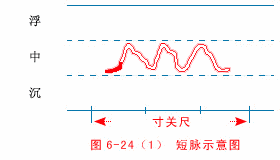
【Body Image Song】 Short pulse is thin and small, with both ends drooping; it rises in the middle, unable to fill the entire area.
【Main Disease Song】 Short pulse indicates insufficiency, primarily due to qi deficiency. A short pulse at the cun indicates unstable heart qi; a short pulse at the right cun indicates lung deficiency and headache. A short pulse at the left guan indicates liver qi injury; a short pulse at the right guan indicates issues in the diaphragm. A short pulse at the left chi indicates lower abdominal pain; a short pulse at the right chi indicates insufficient fire.
(11) Surging pulse:

【Body Image Song】 Surging pulse is extremely large, resembling a flood; it rises and falls, overflowing the fingers.
【Main Disease Song】 Surging pulse indicates fullness, with qi stagnation and excessive heat. A surging pulse at the left cun indicates anxiety and tongue sores; a surging pulse at the right cun indicates fullness and qi reversal. A surging pulse at the left guan indicates excessive liver wood; a surging pulse at the right guan indicates bloating and heat. A surging pulse at the left chi indicates water deficiency; a surging pulse at the right chi indicates excessive fire.
(12) Weak pulse:
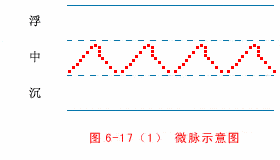
【Body Image Song】 Weak pulse is extremely fine and soft; it is almost imperceptible, as if it might disappear.
【Main Disease Song】 Weak pulse is vague, indicating severe deficiency of qi and blood. A weak pulse at the left cun indicates anxiety; a weak pulse at the right cun indicates shortness of breath. A weak pulse at the left guan indicates cold cramps; a weak pulse at the right guan indicates stomach cold. A weak pulse at the left chi indicates extreme deficiency; a weak pulse at the right chi indicates life-threatening conditions.
Today, we have introduced 14 pulse types. Tomorrow, we will continue with the remaining 14. You can take your time to digest this information. TCM treatment is a systematic process that cannot rely solely on pulse diagnosis; all four diagnostic methods—observation, listening, inquiry, and palpation—are essential.
Therefore, while we have a basic understanding of pulse classification, it is merely a superficial recognition of pulse patterns. This is knowledge dissemination; do not hastily make judgments about your health. If you feel unwell, it is essential to seek medical attention promptly.

